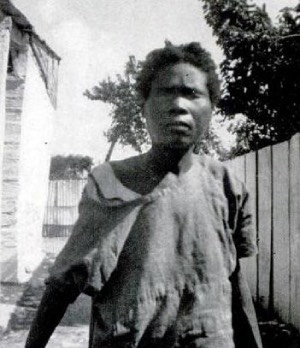
 First photograph of a zombie (Felicia Felix-Mentor), by Zora Neale Hurston, 1937.
First photograph of a zombie (Felicia Felix-Mentor), by Zora Neale Hurston, 1937.
The living dead are widely represented creatures in pop culture, especially since the release of White Zombie in 1932, the first movie staging zombies on wide screen. Nevertheless, this fictional creature originates in a magico religious ritual coming from the voodoo practiced in Haiti.
The voodoo is a religion that appeared in the gulf of Benin and that was exported in the Carribbeans with the slade trade that began in the 15th century. Death is a crucial element of these beliefs and many an Haitian put their souls under the protection of a loa who is a deity. Besides, etymologically speaking, the term “zombie” comes from the Haitian Creole zonbi that means “dead under the influence of a sorcerer.” Thus, the zombification is one of the well-known ceremonies in the collective imaginary with the voodoo dolls, whereas it is but a part of this not much known religion that mingles magic, superstitions and, indirectly science.
It is an act that is usually used to punish an individual in transforming them into a servile being. A person can call a bokor, they are a priest that practices maleficent magic, so that they poison the victim in order to plunge them into a cataleptic state, before being recognized as being dead by the authorities and then inhumed. A few days later, the person is exhumed to endure a ceremony to be woken up and be given zombi powder, the local name that leads to this transformation. From then on, the zombie knows a state of extreme psychological passivity, which enables to make a slave totally devoid of free will out of them. Then, they can be used for different chores such as working in the sugar cane plantations.
The toxin responsible for the zombification is the tetrodotoxin that is taken by the Haitians in the fufu, the equivalent of which is the fugu in Japan. The first scientific researches on the subject happened in the 1930s with William Seabrook and Zora Hurtson. They have led the first anthropological investigation on the zombies and have participated in their introduction in American pop culture. Afterwards, Wade Davis, a Canadian anthropologist, was the first to really get interested in the 1980s in the way to transform a man into a zombie. He collaborated with doctor Douyon who has worked on the famous case of Clairvius Narcisse. In 1997, in an article published in The Lancet, the two men set out their conclusions on the after-effects of the zombification that would cause, according to them, schizophrenia and brain lesions. Other researches have been conducted within the psychiatric hospital of Port-au-Prince in the early 2010s to determine the effects of drugs on individuals touched by this plague. For instance, doctor Girard discovered that his “zombie” patient was affected with repeated epilectic fits that led to chronic psychoses and amnesias in addition to difficulties to be concentrated, a spatiotemporal disorientation and a sexual hyperexcitation.
Beyond medical sciences, the issue of the zombi is a genuine social reality that largely impacts Haitians’ lives. Death is omnipresent on the isle and the fear of being transformed into a “living-dead” is a reality that is still applicable. Under the Duvaliers’ dictatorship, many people thought that the secret police was composed of zombies and that the leaders had magical powers. However, the person that came back to life should be considered as a victim and not as a monster. The unofficial justice which is controlled by the secret societies does not hesitate to apply its own sentences to punish those who are considered as harmful for the community. That is why Haitian doctors and jurists try to make the local penal code evolve as it has not been modified since 1835. The objective is to acknowledge the status of the zombi in order to give a legal existence to the individual who, according to the current laws, no longer has an identity since they have been declared dead to the authorities.
The study of the zombi is thus at the frontier of a rational world ruled by scientific laws and a spiritual and phantasmagoric imaginary world. They arouse fear and fantasy, as demonstrated by the various experimental practices which refer to the rebirth myth, to treat diseases such HIV infection with the neurotoxin responsible for the zombification.
Read more in the dictionary : Drapetomania - Lypemania
Read the paper in French : Zombis
Références :
Philippe CHARLIER, Zombis : enquête sur les morts vivants, Tallandier, coll. Texto, 2018 (1e éd. 2015).
Denis POIZAT, « Le vaudou, la déficience, la chute », Reliance, vol. 29, no. 3, 2008, p. 9-17.
To quote this paper : Paul Cousin, "Zombies" in Hervé Guillemain (ed.), DicoPolHiS, Le Mans Université, 2022.